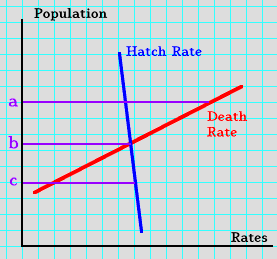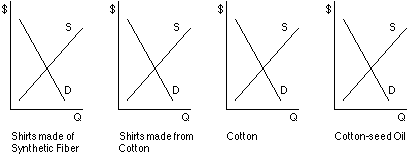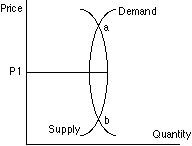
1. An arms race can be seen as a case of a prisoner's dilemma. Draw a payoff matrix showing the results of strategies "less armament" and "more armament" for two hostile nations. (Hint: Assume that war is a result of mistakes: that is, a nation does not go to war if it believes that it will lose. Payoffs then include "stalemate," "dominance," and "subservience.")
less arms
(them) more arms
(them) less arms (you) stalemate \
stalemate subservience \
dominance more arms (you) dominance \
subservience stalemate \
stalemate
The stalemate in the upper left is better than that in the lower right because it is cheaper.
2. The prisoners' dilemma is an example of game theory. Search the internet for "game theory." How is it defined, what is it used for, and who invented it?
Answers will vary.
3. Game theory introduced the terms "zero-sum game," "positive-sum game," and "negative-sum game." A zero-sum game is an interaction among people where the amount lost equals the amount gained. That means that if one person gains, another person must lose.
a. How do you think a positive-sum game would be defined? How about a negative-sum game?Answers will vary.
b. (Javascript question)
Football and poker could be seen as positive sum if one counts the enjoyment of playing as a part of the winnings.
c. Can you think of other examples of zero-sum interactions? Positive-sum interactions? Negative-sum interactions?
Answers will vary.
d. Look up zero-sum, positive-sum, and negative sum on the internet. (You might want to include the word game, or maybe not.) Find at least one example of each that you found.
Answers will vary.
e. Some people think of the world as a struggle for power. Is this way of looking at the world zero-sum, positive-sum, or negative sum?Zero sum.
4. Economists are a bit unusual because they view the world as basically positive-sum. Why? (Hint: Economists mostly study exchange.) Is that a optimistic or pessimistic way of viewing the world?
They study exchange, which is positive sum. It is an optimistic view.
5. You are to split $10 between yourself and an anonymous member
of the class. Your "partner" will either accept or reject your
decision. If he accepts it, you both get what you decided. If he
rejects it, neither of you get anything at all. How would you split
the sum?
I will take _________ and leave _________ for you.
Now suppose that you are the recipient of the offer. How much would you have to be offered to accept?
Can you figure out what would happen if everyone were rationally self-interested in the way the economists assume? Did you make your decision in a way that satisfies rational self interest?
The above problem is known as the "ultimatum game." If you search for it on the web, you should discover why this little problem presents troubling problems for economics.
Answers will vary.
6. While we are looking at strange games, we might as well look at the game of chicken. Search the internet for {"game of chicken" "game theory"}. What is the game of chicken? How is it similar to and different from the prisoner's dilemma?
The lower right box is really bad. The best strategy is to the opposite of the other players. This is a game to avoid.
7. The prisoner's dilemma is widely used to illustrate many things. Do a search on the internet for the term "prisoner's dilemma." From the links you are given, find an topic that the prisoner's dilemma illustrates and which is not one discussed in our readings here.
Who knows what they will find. It is what makes the assignment fun to give.
8. The discussion of the commons suggested that there was a tendency to overgraze land open to all.
a) Suppose that there are only two herders but that each could control up to 300 cattle. Would this change the conclusion? (Hint: Use the table in the discussion of the commons. Draw a payoff matrix assuming that the strategies are "Graze 200" and "Graze 300." Then notice that this is a case in which there are many plays in the game, not just one.)
200 him 300 him 200 you 1400 \ 1400 1080 \ 1620 300 you 1620 \ 1080 1300 \ 1300
The upper right and lower left are illusions. You cannot stay there if both of you are rational. Once you both realize this, you should settle at 200/200.
b) Suppose that there are 100 herders as in the original example, but that the king demands 20% of milk production as a tax. What would he do if he wanted to maximize his tax receipts?
He could require people to have a license to use the land, and limit the licenses to 400. There are other solutions as well.
9. It is rush hour in Chicago and you want to go home. You have two routes you can travel. One is not congested but has traffic signals. If you use it, you will arrive home in 30 minutes. You will not slow down any other driver. The other route is the freeway, which is becoming crowded. If you use it, you will make it more congested and slow down 200 other drivers by five seconds. You will also arrive home in 25 minutes. Assume that the pleasantness or unpleasantness of both routes is identical. Which route will you choose? From the point of view of all people who your decision affects, which is the best decision? Can you see that this is a situation with the same logic as the hand/fist game has?
You will choose the one fastest for you, the freeway. If you took into account all the consequences of your actions, you should chose the other route. We play the hand/fist game all the time.
10. Substitute teachers are not treated with the same respect by high-school students as are regular teachers. Explain why in terms of the various stories of the prisoner's dilemma that we have seen so far.
The interaction with the substitute is often a one-play game, while that with the regular teacher is an ongoing game. Cooperative behavior is more likely in the on-going game.
11. Primitive societies of hunter-gatherers have neither property rights nor strong central authorities. a) How can they avoid the problems of coordination and conflict over scarce resources? (Hint: They also have very low population densities. What does this do to a problem of the commons?)
Game is not a scarce resource if population densities are low enough. There is enough for everyone. There is no economic problem to solve.
b) Does your answer suggest a theory about how and when property rights come into being?
Property rights become a problem as population densities rise. Economic problems arise because game and other items become scarce--there is no longer enough for everyone. Domestication of animals was a way of claiming property rights. It became necessary with higher population densities.
13. Some years ago, the farmers in one of the Caribbean nations were having a problem with snakes that ate chicken eggs. To solve the problem, the government instituted a bounty on the snakes. The program worked well at first, but then the authorities noticed that rather than decreasing, the number of snakes being turned in was increasing. Investigating, they found that the bounty had been set too high. What unwanted incentive would very high bounties give people?
I have seen this story about several different locations. It may be an economics urban legend. The unwanted result was that people began to raise snakes.
13. Two miners are having an argument over who has the slower mule. They decide to settle the argument with a race to the nearest saloon; the owner of the mule that arrives first will buy the drinks for the other miner. They each get on their mules and do nothing. An economist finds them two hours later, neither having moved a foot. He asks what their problem is. They get down off their mules and explain the situation to him. He thinks about the situation a few seconds and says two words. The miners immediately jump back on the mules and race off to the saloon. What did the economist say to resolve this problem? (Comment: This problem is adapted from a similar story in David Friedman's Hidden Order.)
"Switch mules."
1. (This is now in Javascript.) A profit-maximizing professor asks her class the maximum they would pay for an A. These are the numbers she gets: $100, $50, $75, $0, $200, $0, $500, $50, $50, $10, $25, $75, $50. Construct a table that shows the demand curve for As in this class.
What some students will not see is that a person willing to pay $200 for an A will be willing to pay less than $200 for an A. Because they do not see this, they will get a very strange demand curve.
$500 -- 1
$200 --2
$100 --3
$75 -- 5
etc.
2. Discussing the tuition and fees of a college, one of the financial administrators was worried that the institution was close to the "tipping point" in the cost-benefit calculations students and parents made when choosing a college. If there is a "tipping point" for tuition and fees, what does the demand curve for this college look like? Would an economist draw the demand curve this way? Why or why not?
This implies that there is a bend or elbow in the curve. At the top, the demand curve is flat, then it hits the bend, then it gets very steep. There is a tipping point for each possible student, but it is unclear why it should be roughly the same for most people. For some people the tipping point is at $2000, for others at $7000, for others at $15000, etc. Given that each person has his or her own tipping point, why should the demand curve have an elbow?
2.(Now in Javascript) Assume that normal supply and demand curves can represent the American market for beef. As a result of each event below, indicate in which direction the supply and demand curves will move (right or left) and what happens to equilibrium price and quantity.
|
|
|
|
|
|
|
A. The price of cattle feed rises. |
|
|
|
|
|
B. People start worrying about the sanitation in meat-slaughtering houses. |
|
|
|
|
|
C. A severe winter destroys 5% of the herds. |
|
|
|
|
|
D. The ban on the use of DES (a growth hormone used for cattle) is lifted. |
|
|
|
|
|
E. In an effort to aid farmers, government grants a subsidy of $.05 per pound for beef produced. |
|
|
|
|
|
F. Government grants farmers a subsidy of $10 per acre of land they own. |
|
|
|
|
|
G. All foreign beef is excluded from the American market. |
|
|
|
|
|
H. Per-capita income rises. |
|
|
|
|
|
I. Housewives expect rising beef prices. |
|
|
|
|
|
J. Food companies improve the taste of their soybean meat substitutes. |
|
|
|
|
|
K. The price of ham falls. |
|
|
|
|
|
L. A cheap and perfect substitute for leather is developed. |
|
|
|
|
|
M. The price of milk decreases and dairy farmers sell their herds. |
|
|
|
|
|
N. The price of ketchup (a complementary good) rises. |
|
|
|
|
|
Note: For the last three events, determine the price and quantity that will appear in the market. They may not be equilibrium prices or quantities. |
||||
|
O. The government establishes a price ceiling above equilibrium price. |
|
|
|
|
|
P. The government establishes a price ceiling below equilibrium price. |
|
|
|
|
|
Q. The government sets a price floor above equilibrium price. |
|
|
|
|
Warning: Several of the items above are slightly ambiguous and the answer you give depends on the assumptions you make.
4. Suppose that an ecologist is studying the population of the
golden-throated song sparrow and he finds the relationships
illustrated in the graph below between the hatch and death rates and
population, given that the existing food supply, level of predation,
and so on are fixed.
a) What will happen if the population is at level a? At level b? At
level c? at a population will decrease, at b it is in equilibrium, at
c it will increase.

b) Show on the graph what will happen if the food supply increases.
Either death rate will shift left, or hatch rate will shift right, or both of those shifts will take place. Equilibrium population will rise.
c) Explain what will happen on the graph if, due to an increase in the use of pesticides, fewer eggs hatch.
Hatch rate shifts left and population falls.
d) Explain what will happen on the graph if the number of
predators increases.
Death rate shifts right and population
falls.
e) In what ways do the mechanics of this model resemble the mechanics of the supply and demand model?
It works just like supply and demand. If you understand this model, you should understand supply and demand. And vise versa.
5. Suppose the markets shown below may be described by supply and demand curves. Show what should happen in each market as a result of a sharp increase in the price of petrochemicals from which synthetic fibers are made. Add a note of explanation to each graph. (Hint: work from left to right and ignore any feedback.)

First Graph. Supply left, price up, q down.
Second Graph. Demand right (substitute good), p up, q up.
Third Graph. Demand right (derived demand--it is the resource used in shirts); p up and q up
Fourth Graph. Supply right (it is a byproduct of producing cotton fiber); p down and q up.
6. "If the price goes down, the seller will have to sell more to make the same profit. Hence the supply curve should have a negative slope just as the demand curve does." What is wrong with this reasoning? (Hint: What did we assume about the level of profits a firm seeks? According to this quotation, what would happen to profits if a seller sells more at the original, high price?)
If the seller can sell more with a lower price to increase profit, why did he not sell more with the original price? If he could have sold more at the original price and increased profit, they he was not maximizing profit to start with. But the supply curve is based on the assumption that sellers are maximizing profit.
7. Suppose price is at P1 in the figure below. What will the adjustment process cause to happen? Is there any difference between equilibria a and b?

At p1 there is a surplus, so price will fall to b. Intersection a is an unstable equilibrium--an egg standing on an end.